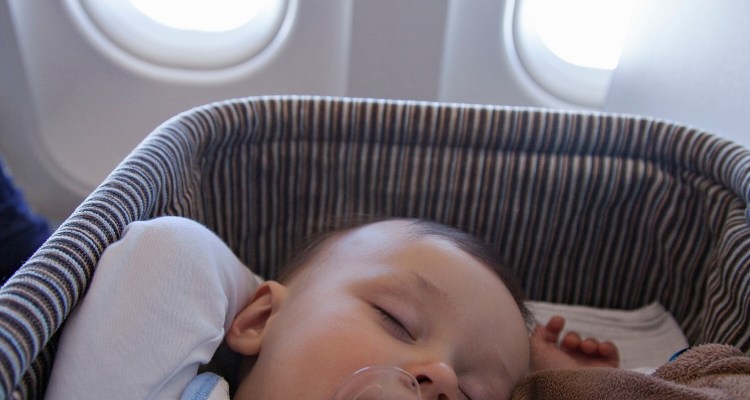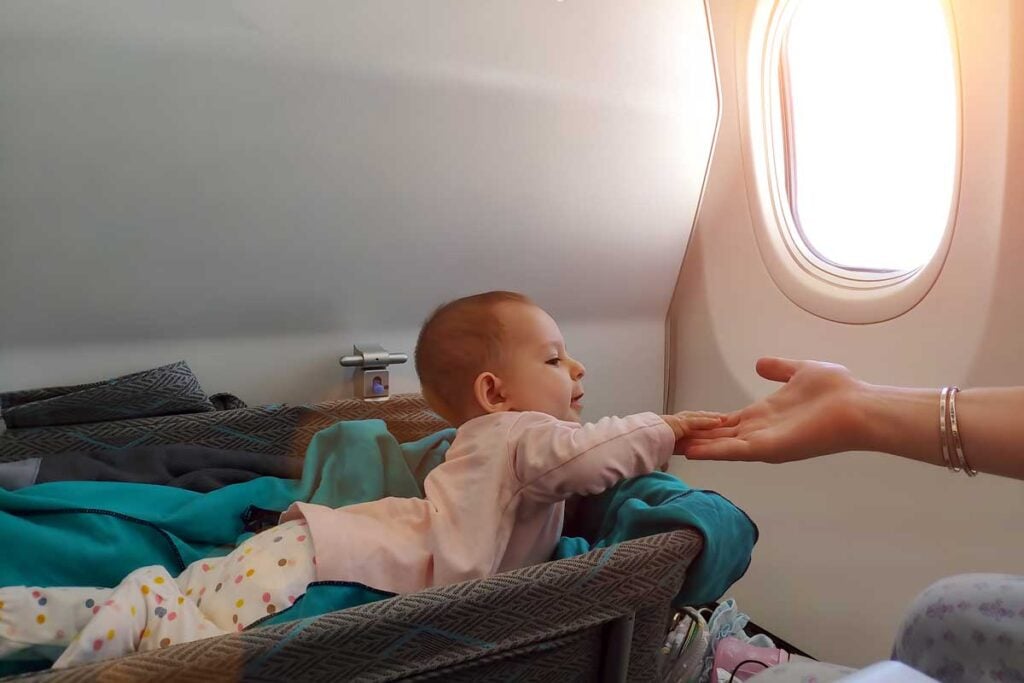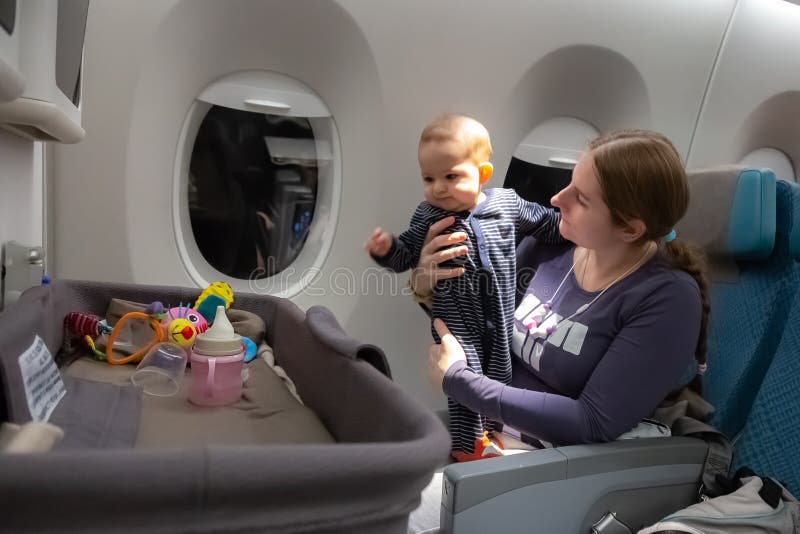Airplane bassinet seats are a lifesaver for parents traveling with infants, offering a convenient way to ensure comfort and safety during long flights. These specially designed seats provide a secure spot for babies to rest, allowing parents some much-needed reprieve and peace of mind. Understanding how these seats work, who can use them, and their limitations can greatly enhance your travel experience with a young child. In this guide, we delve into everything you need to know about airplane bassinet seats to help you prepare for your next journey.
What is an Airplane Bassinet Seat?
An airplane bassinet seat is a fold-down crib-like structure attached to the aircraft bulkhead, typically located in the front rows of the economy cabin. These seats are designed to accommodate infants under a certain weight limit (usually around 20-25 pounds or 9-11 kilograms) and height restriction (generally up to about 28 inches or 71 centimeters). The bassinet itself is a small, cozy bed with safety straps to secure the baby during turbulence or takeoff/landing.

How to Reserve an Airplane Bassinet Seat
Reserving an airplane bassinet seat requires early planning and coordination with the airline. Not all aircraft have bassinet facilities, and availability is limited. It’s advisable to request these seats at the time of booking or soon after, as they are allocated on a first-come, first-served basis. Airlines typically have specific guidelines regarding the eligibility criteria for using bassinets, such as the age, weight, and height of the infant.
Eligibility Criteria for Using Airplane Bassinet Seats
To use an airplane bassinet seat, your infant must typically be under a certain age (usually between 0-6 months) and meet the airline’s weight and height restrictions. These restrictions ensure the safety and comfort of the child while using the bassinet. Some airlines may also have additional requirements or recommendations, such as providing a doctor’s certificate confirming the infant’s suitability for travel in a bassinet.

Pros and Cons of Airplane Bassinet Seats
Airplane bassinet seats offer several advantages, such as allowing parents to have their hands free during the flight, providing a comfortable sleeping environment for the baby, and reducing overall stress during travel. However, there are also limitations to consider. Bassinets have weight and size restrictions, may not be available on all flights or aircraft types, and often cannot be used during turbulence or when the seatbelt sign is illuminated.
How to Use an Airplane Bassinet Seat
Using an airplane bassinet seat involves a few simple steps to ensure your baby’s safety and comfort. Once airborne and when the seatbelt sign is off, cabin crew will assist in setting up the bassinet securely against the bulkhead wall. It’s essential to follow crew instructions regarding placing your baby inside, securing the safety straps, and ensuring proper ventilation and comfort within the bassinet.
Tips for Using Airplane Bassinet Seats Effectively
Maximize your experience with an airplane bassinet seat by preparing in advance. Bring essential items such as baby blankets, toys, diapers, and formula to keep your infant comfortable throughout the flight. Dress your baby in layers to accommodate changing temperatures, and consider feeding your baby during takeoff and landing to alleviate ear discomfort caused by air pressure changes.

Limitations and Considerations
While airplane bassinet seats are convenient, they do come with limitations. These include weight and size restrictions, availability issues, and restrictions on use during turbulence or certain phases of flight. It’s essential to check with your airline beforehand and manage your expectations regarding the use of bassinets to avoid disappointment during your journey.
Airlines with the Best Airplane Bassinet Seat Options
Not all airlines offer bassinet seats, and the quality of these seats can vary significantly. Some airlines are known for their excellent bassinet facilities, including spacious seats, comfortable bedding, and attentive service. Researching airlines that prioritize family travel and offer reliable bassinet options can make a significant difference in your overall travel experience.
Safety Considerations
Safety is paramount when using an airplane bassinet seat. Always ensure that your baby fits within the weight and height limits specified by the airline, secure the safety straps properly, and follow crew instructions at all times. Avoid placing bulky items or excessive bedding inside the bassinet, as these can pose a safety hazard during turbulence or sudden movements.

FAQs About Airplane Bassinet Seats
To further aid your understanding and preparation, here are some frequently asked questions regarding airplane bassinet seats:
1. Can I bring my own bassinet on the plane?
Most airlines do not allow passengers to use their own bassinets due to safety and compatibility concerns. It’s best to rely on the airline-provided bassinets, which are designed and approved for use on their specific aircraft.
2. How do I know if my flight offers bassinet seats?
Check with the airline directly or review the seating chart of your specific flight during the booking process. Many airlines list the availability of bassinet seats on their websites, but confirming with customer service can provide additional assurance.
3. Can I use the bassinet during takeoff and landing?
No, bassinets cannot be used during takeoff, landing, or when the seatbelt sign is on. During these times, you will need to hold your infant securely in your lap with an infant seatbelt provided by the cabin crew.
4. Is there an extra cost for reserving a bassinet seat?
Policies vary by airline; some may offer bassinet seats at no additional cost, while others might charge a fee or require you to book a specific class or fare type. Always check with your airline to understand any associated costs.
5. How do I entertain my baby during the flight?
Bring along small toys, pacifiers, and other comfort items that your baby enjoys. Feeding your baby during key moments like takeoff and landing can also help keep them calm by alleviating ear pressure.

Conclusion
Airplane bassinet seats provide a practical solution for parents traveling with infants, offering a safe and comfortable environment for babies to sleep during long flights. By understanding the eligibility criteria, limitations, and tips for using these seats effectively, you can enhance your travel experience and ensure a smoother journey for both you and your little one. Planning ahead, communicating with the airline, and preparing essential items can make a significant difference in how well your baby adapts to air travel. With careful preparation and awareness, airplane bassinet seats can make traveling with an infant more manageable and less stressful.
